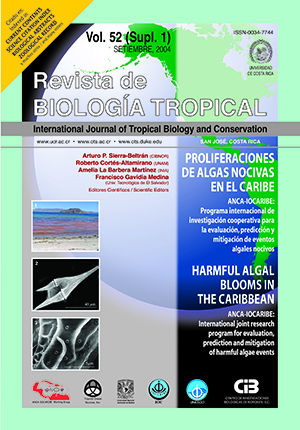Abstract
Harmful Algae Blooms (HAB) are a frequent phenomenon in the Gulf of Nicoya, Costa Rica, as in other parts of the world. The morphology and physiology of these microalgae are important because HAB species have adaptive characteristics. The production of high concentrations of paralytic toxins by Ceratium dinoflagellates has only been documented at the experimental level. However, this genus has been associated with the mortality of aquatic organisms, including oyster and shrimp larva, and fish, and with decreased water quality. Recently, fishermen reported massive mortality of encaged fish near Tortuga Island (Gulf of Nicoya). Samples were taken from an algal bloom that had produced an orange coloration and had a strong foul-smelling odor. Ultrastructural details were examined with scanning electron microscopy. The dinoflagellates Ceratium dens, C. furca and C. fusus were found in samples taken at the surface. The cell count revealed four million cells of this genus per liter. The morphological variability of these species is high; therefore electron microscopy is an useful tool in the ultrastructural study of these organisms. This is the first time that three Ceratium species are reported concurrently producing harmful blooms in Costa Rica.References
Balech, E. 1988. Los Dinoflagelados del Atlántico Suboccidental. Publicaciones especiales, Instituto Español de Oceanografía. Número 1. 310 p.
Cortés, R. & R. Alonso. 1997. Mareas rojas durante 1997 en la Bahía de Mazatlán, Sinaloa, México. 1997. Rev. Cien. Mar. U.A.S. 15: 31-37
Cortés, R. & A. Núñez. 2000. Distribución y abundancia anual de Ceratium dens (Peridiniales: Ceratiaceae) en el Golfo de California, México. Rev. Biol. Trop. 48: 305-311.
Glibert, P.M. & G. Pitcher. 2001. Global Ecology and Oceanography of Harrmful Algal Blooms. Science Plan. An International Programme Sponsored by the Scientific Committee on Oceanic Research (SCOR) and the Intergovernmental Oceanographic Commission (UNESCO). 86 p.
Hallegraeff, G.M., D.M. Anderson & A.D. Cembella. 1995. Manual of Harmful Marine Microalgae. Intergovernmental Oceanographic Commission. 551 p.
Hargraves, P. & R. Víquez. 1981. The dinoflagellate red tide in Golfo de Nicoya, Costa Rica. Rev. Biol. Trop. 29: 31-38.
Hargraves, P. & R. Víquez. 1985. Spatial and temporal distribution of phytoplankton in the Gulf of Nicoya, Costa Rica. Bull. Mar. Sci. 37:577-585.
Hernández-Becerril, D. & N. Navarro. 1996. Thecate dinoflagellates (Dinophyceae) from Bahía Fosforescente, Puerto Rico. Rev. Biol. Trop. 44: 465-475.
Hernández, F. & R. Guillén. 2000. Microwave Processing for Scanning Electron Microscopy. Eur. J. Morphol. 38: 109-111.
La Barbera Sánchez, A. 1993. Dinoflagelados de la región Nor-Oriental de Venezuela. Centro de Investigaciones Agropecuarias de Estado de Sucre, Cumaná, Venezuela. 93 p.
Landsberg, J. 2002. The Effects of Harmful Algae Blooms on Aquatic Organisms. Rev. Fish. Sci. 10 (2): 1-412.
Mata L., G. Abarca, L. Marranghello & R. Víquez. 1990. Intoxicación paralítica por mariscos (IPM) por Spondylus calcifer contaminado con Pyrodinium bahamense, Costa Rica. Rev. Biol. Trop. 38: 129-136.
Mata, A. & O. Blanco. 1994. La Cuenca del Golfo de Nicoya: un reto al desarrollo sostenible. Universidad de Costa Rica. 235 p.
Mijares, A.J., C. Sevcik, C.A. Barboza & J.A. Saavedra. 1985. Ichthyotoxism by a paralytic toxin produced by marine dinoflagellates of the genus Ceratium: relationship to fraction β isolated from the sponge Tedania ignis. Toxicon 23: 221-233.
Tomas, C.R. (ed.) 1997. Identifying marine phytoplankton. Academic. New York. 858 p.
Víquez, R. & P. Hargraves. 1995. Annual cycle of potentially harmful dinoflagellates in the Golfo de Nicoya, Costa Rica. Bulll. Mar. Sci. 57(2): 467-475.
Comments

This work is licensed under a Creative Commons Attribution 4.0 International License.
Copyright (c) 2004 Revista de Biología Tropical


